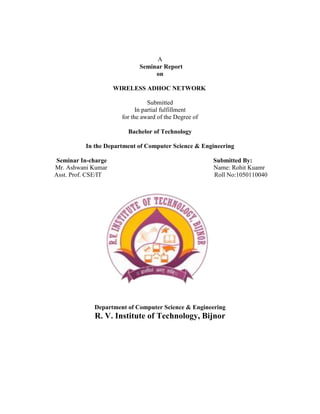
A
- 1. A Seminar Report on WIRELESS ADHOC NETWORK Submitted In partial fulfillment for the award of the Degree of Bachelor of Technology In the Department of Computer Science & Engineering Seminar In-charge Submitted By: Mr. Ashwani Kumar Name: Rohit Kuamr Asst. Prof. CSE/IT Roll No:1050110040 Department of Computer Science & Engineering R. V. Institute of Technology, Bijnor
- 2. ABSTRACT When n identical randomly located nodes, each capable of transmitting at W bits per second and using a fixed range, form a wireless network, the throughput λ(n) obtainable by each node for a randomly chosen destination is Θ(W/√(nlogn)) bits per second under a noninterference protocol. If the nodes are optimally placed in a disk of unit area, traffic patterns are optimally assigned, and each transmission's range is optimally chosen, the bit-distance product that can be transported by the network per second is Θ(W√An) bit-meters per second. Thus even under optimal circumstances, the throughput is only Θ(W/√n) bits per second for each node for a destination nonvanishingly far away. Similar results also hold under an alternate physical model where a required signal-to-interference ratio is specified for successful receptions. Fundamentally, it is the need for every node all over the domain to share whatever portion of the channel it is utilizing with nodes in its local neighborhood that is the reason for the constriction in capacity. Splitting the channel into several subchannels does not change any of the results. Some implications may be worth considering by designers. Since the throughput furnished to each user diminishes to zero as the number of users is increased, perhaps networks connecting smaller numbers of users, or featuring connections mostly with nearby neighbors, may be more likely to be find acceptance.
- 3. ACKNOWLEDGEMENT The seminar report on “WIRELESS ADHOC NETWORK” is outcome of guidance, moral support and devotion bestowed on us throughout our work. For this we acknowledge and express our profound sense of gratitude and thanks to everybody who have been a source of inspiration during the project preparation. It is with profound gratitude that we express our deep indebtedness to our Seminar Guide Mr. Ashwani Kumar & Mr.Amit Ravi without whose support and guidance it would not have been possible for this Seminar to have materialized and taken a concrete shape. We offer our sincere phrases of thanks with innate humility to Ms. Pooja Verma H.O.D. CSE/IT for providing their precious ideas, suggestions and help that enabled in shaping the Seminar work. Last but not the least we are indebted to our parents and friends for their constant encouragement and helping us in our endeavor.
- 4. Candidate’s Declaration I hereby declare that the work, which is being presented in the Seminar, entitle”… ……WIRELESS ADHOC NETWORK………” in partial fulfillment for the award of Degree of “Bachelor of Technology” in Department Of Computer Science & Engineering and submitted to the Department of Computer Science & Engineering, R. V. Institute of Technology Bijnor, is a record of my own investigations carried under the Guidance of Mr. Ashwani Kumar, Asst Prof. CSE/IT R. V. Institute of Technology Bijnor. I have not submitted the matter presented in this seminar anywhere for the award of any other Degree. Name:Rohit Kumar Branch: Computer Science & Engineering Roll No:1050110040 R. V. Institute of Technology Bijnor
- 5. Contents Chapter- 1 Wireless Ad-Hoc Network Introduction1 1 Chapter- 2 Set Up A Computer-To-Computer (Ad Hoc) Network 4 2.1advantages 6 2.2disadvantages 6 Chapter- 3 Security In Wireless Network Connections 7 3.1 Other Limitations To Wireless Networks 7 3.2 Cost Associated With Wireless Network 8 Chapter- 4 Application 9 Chapter- 5 Technical Requirements 10 5.1 Medium-Access Control 10 5.2 Simulation Of Wireless Ad Hoc Networks 10 5.3 Routing Protocols 12 Chapter- 6 Security 16 Chapter- 7 The Future Of Ad Hoc Networks 19 7.1 The Future Of Ad-Hoc Networks 19 7.2 Wand 20 Chapter- 8 Wireless Network Architectures 24 8.1 Standalone Architecture (Ad Hoc Mode) 24 8.2 Centrally Coordinated Architecture (Infrastructure Mode) 25 8.3 Ad Hoc Networks And The Internet 27 Chapter- 9 Advantage And Disadvantage 28 9.1 Advantage 28 9.2 Main Disadvantage 28
- 6. Chapter- 10 Automatic Ip Address Configuration 29 10.1 Windows Vista 29 10.2 Network Access Points 31 10.3 Group Ad-Hoc Networks 32 10.4 Pan Scenarios Stack 32 10.5 Network Access Point Profile Stack 33 10.6 Roles/Configurations 33 Chapter- 11 Conclusion 35 Chapter- 12 References 36
